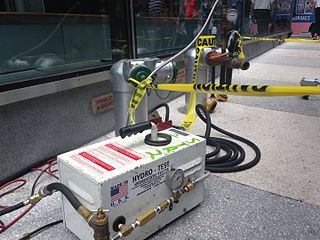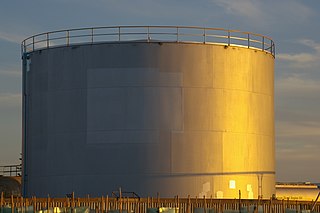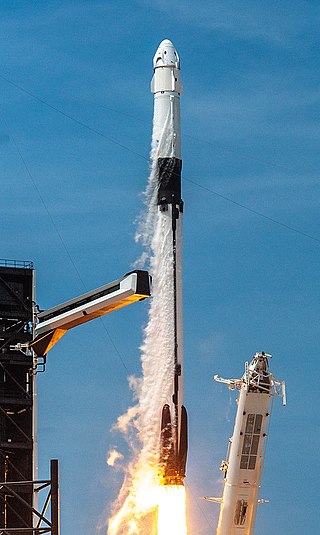Fiberglass or fibreglass is a common type of fiber-reinforced plastic using glass fiber. The fibers may be randomly arranged, flattened into a sheet called a chopped strand mat, or woven into glass cloth. The plastic matrix may be a thermoset polymer matrix—most often based on thermosetting polymers such as epoxy, polyester resin, or vinyl ester resin—or a thermoplastic.

A hydrostatic test is a way in which pressure vessels such as pipelines, plumbing, gas cylinders, boilers and fuel tanks can be tested for strength and leaks. The test involves filling the vessel or pipe system with a liquid, usually water, which may be dyed to aid in visual leak detection, and pressurization of the vessel to the specified test pressure. Pressure tightness can be tested by shutting off the supply valve and observing whether there is a pressure loss. The location of a leak can be visually identified more easily if the water contains a colorant. Strength is usually tested by measuring permanent deformation of the container.

A diving cylinder or diving gas cylinder is a gas cylinder used to store and transport high pressure gas used in diving operations. This may be breathing gas used with a scuba set, in which case the cylinder may also be referred to as a scuba cylinder, scuba tank or diving tank. When used for an emergency gas supply for surface supplied diving or scuba, it may be referred to as a bailout cylinder or bailout bottle. It may also be used for surface-supplied diving or as decompression gas. A diving cylinder may also be used to supply inflation gas for a dry suit or buoyancy compensator. Cylinders provide gas to the diver through the demand valve of a diving regulator or the breathing loop of a diving rebreather.

A pressure vessel is a container designed to hold gases or liquids at a pressure substantially different from the ambient pressure.

Autofrettage is a work hardening process in which a pressure vessel is subjected to enormous pressure, causing internal portions of the part to yield plastically, resulting in internal compressive residual stresses once the pressure is released. The goal of autofrettage is to increase the pressure carrying capacity of the final product. Inducing residual compressive stresses into materials can also increase their resistance to stress corrosion cracking; that is, non-mechanically-assisted cracking that occurs when a material is placed in a corrosive environment in the presence of tensile stress. The technique is commonly used in manufacture of high-pressure pump cylinders, warship and gun barrels, and fuel injection systems for diesel engines. Due to work hardening process it also enhances wear life of the barrel marginally. While autofrettage will induce some work hardening, that is not the primary mechanism of strengthening.

A gas cylinder is a pressure vessel for storage and containment of gases at above atmospheric pressure. High-pressure gas cylinders are also called bottles. Inside the cylinder the stored contents may be in a state of compressed gas, vapor over liquid, supercritical fluid, or dissolved in a substrate material, depending on the physical characteristics of the contents. A typical gas cylinder design is elongated, standing upright on a flattened bottom end, with the valve and fitting at the top for connecting to the receiving apparatus.
In mechanics, a cylinder stress is a stress distribution with rotational symmetry; that is, which remains unchanged if the stressed object is rotated about some fixed axis.
White Sands Test Facility (WSTF) is a U.S. government rocket engine test facility and a resource for testing and evaluating potentially hazardous materials, space flight components, and rocket propulsion systems. NASA established WSTF on the White Sands Missile Range in 1963. WSTF services are available to NASA, the United States Department of Defense, other federal agencies, universities and commercial industry. WSTF is managed by the Lyndon B. Johnson Space Center. WSTF is located in the western foothills of the Organ Mountains, eleven miles east of Las Cruces, New Mexico.
Filament winding is a fabrication technique mainly used for manufacturing open (cylinders) or closed end structures. This process involves winding filaments under tension over a rotating mandrel. The mandrel rotates around the spindle while a delivery eye on a carriage traverses horizontally in line with the axis of the rotating mandrel, laying down fibers in the desired pattern or angle to the rotational axis. The most common filaments are glass or carbon and are impregnated with resin by passing through a bath as they are wound onto the mandrel. Once the mandrel is completely covered to the desired thickness, the resin is cured. Depending on the resin system and its cure characteristics, often the mandrel is autoclaved or heated in an oven or rotated under radiant heaters until the part is cured. Once the resin has cured, the mandrel is removed or extracted, leaving the hollow final product. For some products such as gas bottles, the 'mandrel' is a permanent part of the finished product forming a liner to prevent gas leakage or as a barrier to protect the composite from the fluid to be stored.
Ballistic foam is a foam that sets hard. It is widely used in the manufacture and repair of aircraft to form a light but strong filler for aircraft wings. The foam is used to surround aircraft fuel tanks to reduce the chance of fires caused by the penetration of incendiary projectiles.

Storage tanks are containers that hold liquids, compressed gases or mediums used for the short- or long-term storage of heat or cold. The term can be used for reservoirs, and for manufactured containers. The usage of the word tank for reservoirs is uncommon in American English but is moderately common in British English. In other countries, the term tends to refer only to artificial containers.

A expansion joint, or movement joint, is an assembly designed to hold parts together while safely absorbing temperature-induced expansion and contraction of building materials. They are commonly found between sections of buildings, bridges, sidewalks, railway tracks, piping systems, ships, and other structures.

A hydrogen tank is used for hydrogen storage. The first type IV hydrogen tanks for compressed hydrogen at 700 bars were demonstrated in 2001, the first fuel cell vehicles on the road with type IV tanks are the Toyota FCHV, Mercedes-Benz F-Cell and the GM HydroGen4.
FRP is a modern composite material of construction for chemical plant, pulp and paper mill, and food and pharmaceutical equipment like tanks and vessels. Chemical equipment that range in size from less than a metre to 20 metres are fabricated using FRP as material of construction.

In materials science ceramic matrix composites (CMCs) are a subgroup of composite materials and a subgroup of ceramics. They consist of ceramic fibers embedded in a ceramic matrix. The fibers and the matrix both can consist of any ceramic material, including carbon and carbon fibers.
Out of autoclave composite manufacturing is an alternative to the traditional high pressure autoclave (industrial) curing process commonly used by the aerospace manufacturers for manufacturing composite material. Out of autoclave (OOA) is a process that achieves the same quality as an autoclave but through a different process. OOA curing achieves the desired fiber content and elimination of voids by placing the layup within a closed mold and applying vacuum, pressure, and heat by means other than an autoclave. An RTM press is the typical method of applying heat and pressure to the closed mold. There are several out of autoclave technologies in current use including resin transfer molding (RTM), Same Qualified Resin Transfer Molding (SQRTM), vacuum-assisted resin transfer molding (VARTM), and balanced pressure fluid molding. The most advanced of these processes can produce high-tech net shape aircraft components.
Sustained load cracking, or SLC, is a metallurgical phenomenon that occasionally develops in pressure vessels and structural components under stress for sustained periods of time.
Thermoplastics containing short fiber reinforcements were first introduced commercially in the 1960s. The most common type of fibers used in short fiber thermoplastics are glass fiber and carbon fiber . Adding short fibers to thermoplastic resins improves the composite performance for lightweight applications. In addition, short fiber thermoplastic composites are easier and cheaper to produce than continuous fiber reinforced composites. This compromise between cost and performance allows short fiber reinforced thermoplastics to be used in myriad applications.

A gas cabinet is a metallic enclosure which is used to provide local exhaust ventilation system for virtually all of the gases used or generated in the semiconductor, solar, MEMS, NANO, solar PV, manufacturing and other advanced technologies.

Falcon 9 Block 5 is a partially reusable two-stage-to-orbit medium-lift launch vehicle designed and manufactured in the United States by SpaceX. It is the fifth version of Falcon 9 Full Thrust, powered by SpaceX Merlin engines burning rocket-grade kerosene (RP-1) and liquid oxygen (LOX).












